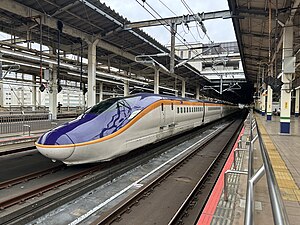| E8 series | |
|---|---|
 Set G1 undergoing testing in July 2023 | |
| In service | 2024–present |
| Manufacturer | |
| Designer | Ken Okuyama |
| Family name | Mini-shinkansen |
| Replaced | E3 series |
| Constructed | 2022-2026 |
| Entered service | 16 March 2024 |
| Number under construction | 98 vehicles (14 sets) |
| Number built | 7 vehicles (1 set) as of January 2023 [update] |
| Formation | 7 cars per trainset |
| Fleet numbers | G1– |
| Capacity | 355 (26 Green + 329 standard) |
| Operators | JR East |
| Depots | Yamagata |
| Lines served | Tohoku Shinkansen, Yamagata Shinkansen |
| Specifications | |
| Doors | 1 per side |
| Maximum speed |
|
| Electric system(s) | 20/25 kV AC, 50 Hz overhead catenary |
| Current collector(s) | Pantograph |
| Safety system(s) | |
| Track gauge | 1,435 mm (4 ft 8+1⁄2 in) standard gauge |
The E8 series (E8系) is a Japanese Shinkansen high-speed train type on order for Tsubasa services announced on 3 March 2020. It will progressively replace the E3 series from 2024 onwards, raising the top speed of the service from 275 to 300 kilometers per hour (171 to 186 mph). It is designed by Ken Okuyama, in cooperation with Kawasaki Heavy Industries. [1]
The train type entered service on 16 March 2024, the start date of the revised timetable for the year. [2] Though 17 sets were originally planned to be built, this was reduced to 15 sets due to reduced travel demand caused by the COVID-19 pandemic. [3] These sets are to be built by Kawasaki Railcar Manufacturing and Hitachi. [4]
The first set, numbered G1, was delivered to Sendai Shinkansen Depot on 30 January 2023. [5]
Design
The train was designed to invoke the richness of the landscape of the Yamagata region, and the "weaving together of nature and people". The exterior coloring is unchanged from the re-liveried E3 series, also designed by Ken Okuyama: white, evoking the snow of Mount Zaō; deep purple inspired by the Mandarin duck, the prefectural bird for Yamagata Prefecture; and yellow and red for the safflower, the prefectural flower of Yamagata Prefecture. [6]
All cars are equipped with full active suspension. [1]
The increased top speed from 275 to 300 kilometers per hour (171 to 186 mph) is possible due to its 9-meter-long (29 ft 6 in) nose, 3 meters (9 ft 10 in) longer than the current E3 series. [7]
Formation
The E8 uses the same 5M2T-formation as the E3 and E6 series mini-shinkansen, meaning that it consists of 5 powered (motor), and 2 non-powered (trailer) cars. [1] [4]
| Car No. | 11 | 12 | 13 | 14 | 15 | 16 | 17 |
|---|---|---|---|---|---|---|---|
| Designation | E811-0 (Msc) |
E828-0 (T1) |
E825-0 (M1) |
E825-100 (M2) |
E827-0 (M3) |
E829-0 (T2) |
E821-0 (Mc) |
- Cars 12 and 16 are each equipped with a single-arm pantograph.
Interior
The 7-car trains have two service classes: ordinary cars and Green cars, with a seating capacity of 355. This is 39 fewer seats than the E3 series trains it replaces. Both seating configurations are 2+2 abreast, as is the case for all other mini-Shinkansen trains. AC power outlets are available in both classes. Both the cabins and vestibules are equipped with security cameras. The green car has room for one wheelchair user, while each ordinary car has room for two. All seven cars are equipped to handle large baggage.[ citation needed]
The color scheme of the Green car seating is inspired by the blue waters of the Mogami River, combined with the lush greenery covering Mount Gassan. The ordinary car seating draws inspiration from the traditional process of extracting the color of the safflower, which is why the color gradually becomes less saturated moving from the seat cushion to the headrest. The center aisle carpet was designed based on the image of the safflower, represented by the seats, reflecting on the waters of the Mogami River as it flows between them. [1]
See also
References
- ^ a b c d "山形新幹線をより便利に快適にします" [Make the Yamagata Shinkansen more convenient and comfortable] (PDF). jreast.co.jp. 東日本旅客鉄道株式会社. 3 March 2020. Archived (PDF) from the original on 3 March 2020. Retrieved 3 March 2020.
- ^ "山形新幹線 25年ぶりの新型車両「E8系」営業運転開始" ["E8 series", begins revenue service, the first new vehicle on the Yamagata Shinkansen in 25 years]. NHK. 16 March 2024. Retrieved 16 March 2024.
- ^ "山形新幹線の新型車両削減" [Reduction in new Yamagata Shinkansen train sets]. Kyodo News Online (in Japanese). 18 May 2022. Archived from the original on 17 May 2022. Retrieved 18 May 2022.
- ^ "New E8 bullet train". Japan Today. 30 January 2023. Archived from the original on 30 January 2023. Retrieved 30 January 2023.
- ^ "山形新幹線E3系のエクステリアデザインを変更" [Exterior design change for Yamagata Shinkansen E3 series]. Japan Railfan Magazine Online (in Japanese). Japan: Koyusha Co., Ltd. 4 March 2014. Retrieved 4 March 2014.
- ^ Hosozawa, Ayateru (23 March 2020). "Ahead by a nose: Faster bullet trains coming to Yamagata in '24". The Asahi Shimbun. Archived from the original on 8 October 2022. Retrieved 31 July 2022.
External links
- Press release (in Japanese)
-
 Media related to
Shinkansen E8 at Wikimedia Commons
Media related to
Shinkansen E8 at Wikimedia Commons



